Search
You are here
Ancient Greek Marseille’s first buildings discovered
A few metres from the Vieux-Port, excavations carried out in the quarter known as the Panier have brought to light the earliest constructions from the period of the Greek colony.
Chronicle of site
Post date
13 May 2005
Last modified
13 February 2017
Prior to the renovation of the College of the Vieux Port, for the Conseil Général of the Bouches du Rhône, the Institut National des Recherches Archéologiques Préventives (INRAP), carried out excavations curated by the Regional Archaeology Service of the Direction régionale des Affaires culturelles Provence-Alpes-Côte-d'Azur. Within stratified deposits three metres deep, archaeologists quickly found occupation levels datable to the Archaic Greek town (600-480 BC). Around 550 BC, the quarter was modified around a large public edifice, perhaps the podium of a temple. The finds discovered in these levels are remarkable.
Going back to the origins of the Greek presence
The area concerned is at the foot of the Saint-Laurent hill, within the initial limits of the Greek town, a few metres from what was the north bank of the antique port. Right from the beginning of the Greek occupation, the steep slope of the land towards the Vieux Port probably made necessary the creation of terraces.
During the first centuries of the Greek occupation (6th-5th century BC), the buildings comprised adobe walls (made of bricks of unfired earth), built on limestone foundation beds, organised according to an apparently orthogonal plan.
During the first centuries of the Greek occupation (6th-5th century BC), the buildings comprised adobe walls (made of bricks of unfired earth), built on limestone foundation beds, organised according to an apparently orthogonal plan.
A temple podium ?
Around 550 BC a monumental edifice was built on the site. From the beginning it had a podium. Rectangular in plan, it was divided into two spaces surrounded by imposing 1.20 metre thick walls. Even though its function is not yet understood, it is certain that it was part of a public building, perhaps religious (temple podium) or military .
It was rapidly completed by different constructions. The unusual plan of these narrow spaces as well as certain architectural indications (large sculpted blocks, blue wall paintings), make it unlikely that they were dwellings. The immediate proximity of the large rectangular building leads one to suppose that this ensemble was part of the same monumental complex covering a square area of about 120m2.
Certain similarities with other sanctuaries of the Greek world are to be noted, as much concerning the organisation of space, construction materials and techniques used, as the date of construction - for example the emporium of Gravisca in Etruria. We may well be in the presence of a 'private' sanctuary, reserved for the emporoï, these shipowners and merchants who brought offerings and celebrated the cult of their protecting divinities (Aphrodite, Herakles, the Dioscuri . . .)
It was rapidly completed by different constructions. The unusual plan of these narrow spaces as well as certain architectural indications (large sculpted blocks, blue wall paintings), make it unlikely that they were dwellings. The immediate proximity of the large rectangular building leads one to suppose that this ensemble was part of the same monumental complex covering a square area of about 120m2.
Certain similarities with other sanctuaries of the Greek world are to be noted, as much concerning the organisation of space, construction materials and techniques used, as the date of construction - for example the emporium of Gravisca in Etruria. We may well be in the presence of a 'private' sanctuary, reserved for the emporoï, these shipowners and merchants who brought offerings and celebrated the cult of their protecting divinities (Aphrodite, Herakles, the Dioscuri . . .)
Objects found
Pottery dominates the finds, there are both local and imported productions. The latter are of Greek origin: Attic, Corinthian, Ionian; others from Rhodes and Etruria. Among the Attic and Corinthian potteries can be found the famous "Black-figure" and "Red-figure" wares characteristic of this period, with very varied decoration.
This tableware is associated with many amphorae mostly from Etruria, but also from Corfu, Athens, Islands of the Aegean Sea and from the Phoenician and Punic worlds.
This tableware is associated with many amphorae mostly from Etruria, but also from Corfu, Athens, Islands of the Aegean Sea and from the Phoenician and Punic worlds.
The context of the discovery
Recently, the ships and the quays of the Places Jules-Verne and Villeneuve-Bargemon were discovered.Other constructions of the Archaic Greek period (6th-5th centuries BC) have been discovered in Marseille (the habitat in front of the Church of Saint Laurent, the Îlot des Pistoles…). But no site is as well preserved and over such a large area
The high quality of the buildings and finds, and the excellent state of conservation of the structures make this an important reference site for the history of France's oldest town, and more widely for the archaeology of the Mediterranean Basin.
The high quality of the buildings and finds, and the excellent state of conservation of the structures make this an important reference site for the history of France's oldest town, and more widely for the archaeology of the Mediterranean Basin.
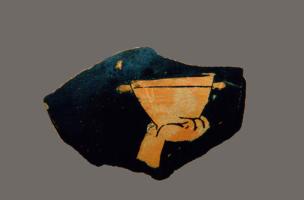
Fragment de vase ouvert attique, skiphos, à figure rouge (500-450 av. J.-C.).
© T. Maziers/Inrap 2005.
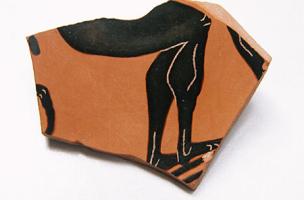
Médaillon central d'une coupe attique (kylix) à figure noire (525-500 av. J.-C.) représentant un personnage accroupi.
© L. de Cargouët/Inrap 2005.
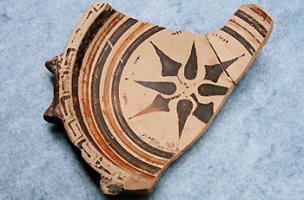
Plat à tige de production locale à pâte claire, première moitié du VIe s. av. J.-C.
© L. de Cargouët/Inrap 2005.

Vue générale du chantier.
© S. Mathie/Inrap 2005.

Vue en coupe d'un mur en adobe de la première moitié du Ve s. av. J.-C.
© S. Mathie/Inrap 2005.

Mur de façade nord du podium grec archaïque, vue depuis l'ouest
© S. Mathie/Inrap 2005.
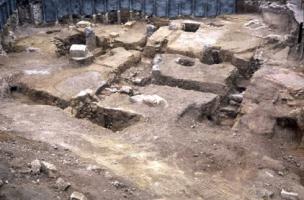
Vue générale des niveaux grecs.
© S. Mathie/Inrap 2005
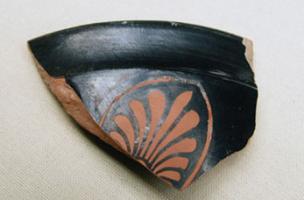
Céramique attique à figure rouge à décor de palmette, Ve siècle av. J.-C.
© L. de Cargouët/Inrap

Personnage dansant sur le médaillon central d'une coupe à figure noire,Ve siècle av. J.-C.
© L. de Cargouët/Inrap
Site Director : Philippe Mellinand (Inrap).
Curation : Regional Archaeology Service of the Direction régionale des Affaires culturelles Provence-Alpes-Côte
Developers : Conseil général des Bouches-du-Rhône.
Contact(s) :
Mahaut Tyrrell
Media communication
Inrap, media partnerships and relations
+33 6 07 40 59 77
mahaut.tyrrell [at] inrap.fr

